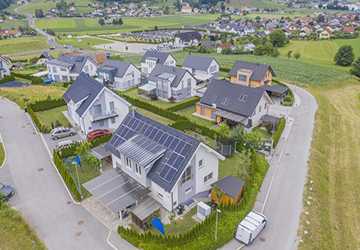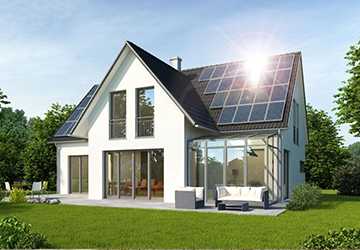In an era of growing environmental awareness and escalating utility costs, eco-friendly home features have become more than just a trend; they are necessary. Not only do these sustainable solutions reduce our carbon footprint, but they also have the potential to save homeowners a substantial amount of money in the long run. From energy-efficient appliances to smart home technology, numerous eco-friendly features can make your home both environmentally responsible and economically savvy. This article will explore the top 10 eco-friendly home features that benefit the planet and contribute to significant savings on your utility bills.

Eco-Friendly Home Features That Save Money
In today's world, the quest for sustainability and cost-efficiency goes hand in hand. As homeowners become increasingly conscious of their environmental impact and the rising expenses of daily life, the demand for eco-friendly home features has surged. In this article, we'll unveil the top 10 eco-friendly home features that are as economically savvy as they are environmentally responsible.
Solar Panels
Solar panels have emerged as one of the most prominent eco-friendly home features, and for good reason. Harnessing the sun's power to generate electricity, solar panels offer homeowners the opportunity to drastically reduce their reliance on traditional energy sources. While the initial installation cost can be substantial, the long-term benefits are undeniable. Solar panels have the potential to decrease your electricity expenses significantly. Sometimes, you can sell your excess energy back to the grid and gain revenue. With technological advancements, solar panels have become more affordable and efficient.
Energy-Efficient Appliances
Replacing obsolete, energy-guzzling appliances with contemporary, energy-efficient alternatives is a wise financial and environmental investment. Energy-efficient appliances, such as ENERGY STAR-rated refrigerators, washing machines, and dishwashers, consume significantly less electricity, lowering monthly utility bills. Additionally, these appliances often come with enhanced features like adjustable settings and intelligent technology, allowing you to customize and optimize their performance, increasing energy savings.
LED Lighting
Swapping out traditional incandescent bulbs for LED lighting is a simple yet effective way to reduce your home's energy consumption. LED bulbs are not only more energy-efficient, but they also have a longer lifespan, meaning fewer replacements and less waste. While LED bulbs may have a higher upfront cost, they use up to 80% less energy and last up to 25 times longer than incandescent bulbs, ultimately saving you money on electricity bills and replacements.

High-Performance Insulation
Proper insulation is critical to maintaining a comfortable indoor temperature and reducing heating and cooling costs. High-performance insulation, such as spray foam or fiberglass, can significantly enhance your home's energy efficiency. By preventing heat from escaping in the winter and keeping cool air in during the summer, you'll reduce the need for constant adjustments to your thermostat, resulting in substantial savings over time.
Programmable Thermostats
A programmable thermostat is a small but mighty addition to your home that can lead to significant energy savings. These smart devices allow you to schedule and automate temperature adjustments based on your daily routine. For example, you can set the thermostat to lower the temperature at work or asleep and raise it at home. This level of control helps reduce energy consumption and keeps your home comfortable while saving you money on heating and cooling costs.
Low-Flow Plumbing Fixtures
Another important part of eco-friendly housing features is water saving. Installing low flow plumbing items like toilets, showerheads, and faucets can help you save water without losing performance. These fixtures are designed to maintain water pressure while using less water, resulting in lower water bills and a reduced environmental impact. Over time, the savings can add up, making low flow fixtures a practical choice for any eco-conscious homeowner.
Rainwater Harvesting System
A rainwater harvesting system is an innovative way to save money and reduce water consumption. By collecting rainwater from your roof and storing it in a tank, you can use it for tasks like watering your garden, washing your car, or flushing toilets. This reduces your reliance on municipal water sources, lowering water bills. Additionally, rainwater is naturally soft and chemical-free, making it an eco-friendly choice for irrigation.
Energy-Efficient Windows and Doors
Windows and doors are often overlooked regarding energy efficiency, but they are crucial in maintaining your home's temperature. Energy-efficient windows and doors are designed to minimize heat transfer, keeping your home cooler in the summer and warmer in the winter. This reduces the strain on your heating and cooling systems, lowering energy bills. Look for windows and doors with high-quality insulation and multiple panes of glass to maximize their effectiveness.
Smart Home Technology
Integrating smart home technology can significantly enhance your home's eco-friendliness and energy efficiency. Smart thermostats, lighting systems, and appliances can be controlled remotely and programmed to operate optimally, ensuring that energy is not wasted when it's not needed. Additionally, the ability to monitor and adjust your home's energy usage through smartphone apps can lead to more informed decisions and further savings.
Sustainable Building Materials
When building or renovating your home, consider using sustainable building materials. Materials like bamboo flooring, reclaimed wood, recycled glass countertops, and low-VOC paints contribute to a healthier indoor environment and reduce the environmental impact of your construction or renovation project. These materials may have higher upfront costs but can lead to long-term savings through improved durability and reduced maintenance.
Conclusion:
Incorporating eco-friendly home features into your living space benefits the environment and provides substantial financial advantages. Several choices are available to lower your ecological impact and save money, ranging from solar panels and energy-efficient appliances to LED lighting and smart home technology. Features like high-performance insulation, low-flow plumbing fixtures, rainwater harvesting systems, and energy-efficient windows and doors can significantly save utility bills. As we continue to face the challenges of climate change and rising energy costs, switching to eco-friendly home features is a proactive and responsible choice.





